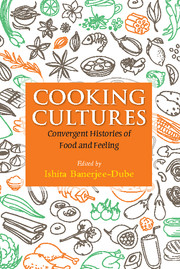Book contents
- Frontmatter
- Contents
- Acknowledgements
- Introduction: Culinary Cultures and Convergent Histories
- Part I Food, Pride, Power
- 1 Indigeneity, Alienness and Cuisine: Are Trout South African
- 2 The Hummus Wars: Local Food, Guinness Records and Palestinian-Israeli Gastropolitics
- 3 Rice, Pork and Power in the Vietnamese Village, 1774–1883
- Part II Cooking, Cuisine, Gender
- Part III Food, Identity, Personhood
- Part IV Food, Myth, Nostalgia
- Contributors
- Index
- References
2 - The Hummus Wars: Local Food, Guinness Records and Palestinian-Israeli Gastropolitics
from Part I - Food, Pride, Power
Published online by Cambridge University Press: 05 July 2016
- Frontmatter
- Contents
- Acknowledgements
- Introduction: Culinary Cultures and Convergent Histories
- Part I Food, Pride, Power
- 1 Indigeneity, Alienness and Cuisine: Are Trout South African
- 2 The Hummus Wars: Local Food, Guinness Records and Palestinian-Israeli Gastropolitics
- 3 Rice, Pork and Power in the Vietnamese Village, 1774–1883
- Part II Cooking, Cuisine, Gender
- Part III Food, Identity, Personhood
- Part IV Food, Myth, Nostalgia
- Contributors
- Index
- References
Summary
Hummus (chickpea paste) is extremely popular in Israel. Culinary establishments that serve hummus in its many forms are the most common fast food venues and cheap eateries in the country; surveys constantly show that hummus is the most popular food in Israeli domestic refrigerators. This chapter intends to weave a tale of appropriation and adaptation, confrontation and cohabitation, hybridity and delineation, and passion and pride centring on hummus, a mundane and ubiquitous dish routinely shared by diners. The ‘elasticity’ of hummus together with the fact that it is meant to be shared, makes it amenable to incessant variations. Hummus is at once an agent of intercultural exchange and an inciter of fierce competition over ‘national pride’ and honour.
By means of a focus on such competitions between two nations engaged in armed conflict – Israel and Lebanon – I will probe how notions of the ‘national’ and the ‘local’, and of authenticity and hybridity get constructed, where ‘appropriation’ props up ‘cultural copyright’ and quantity gains priority over quality in the fight over ‘national pride’. I will also examine the active involvement of Palestinians of Israeli citizenship in a Palestinian-Israeli village in one such competition to reflect on the ‘elasticity’ of hummus as a metaphor for the ‘elasticity’ of belonging and identity, and ponder on the possibility of mapping distinct cartographies of space and region through food.
Hummus is the Arabic term for chickpea beans as well as for the chickpea based dip. The dip is made of boiled chickpeas pound or ground and then mixed with lemon juice, tahini (sesame paste) and olive oil. The dip is seasoned with garlic, salt and pepper, but there are many variations, additions and secrets concerning specific hummus recipes. The dip may be served with a dash of olive oil, with a spoonful of tahini dip (sesame paste mixed with lemon and water), with whole or crushed chickpeas, and with some paprika or parsley that add taste and colour. Mssabaha is a Palestinian breakfast dish made of boiled hummus beans mixed (and not pounded) with tahini dip and olive oil, served with a spicy sauce made of pickled chilies and lemon. Another variation includes foul (fava beans) paste and hardboiled eggs.
- Type
- Chapter
- Information
- Cooking CulturesConvergent Histories of Food and Feeling, pp. 39 - 57Publisher: Cambridge University PressPrint publication year: 2016
References
- 1
- Cited by



